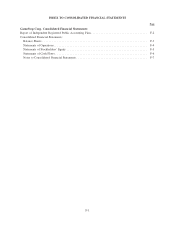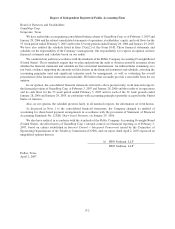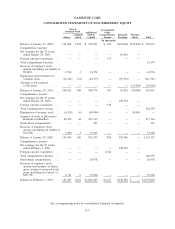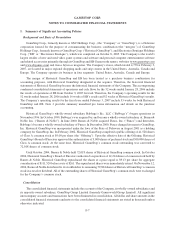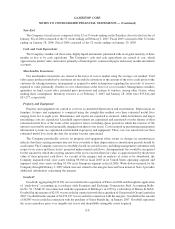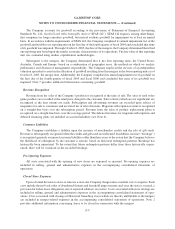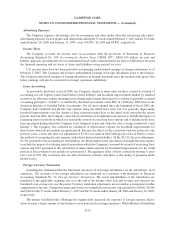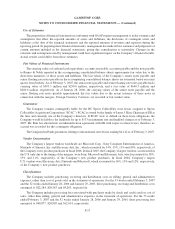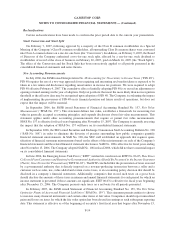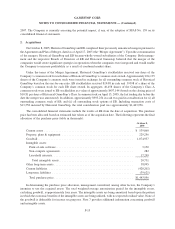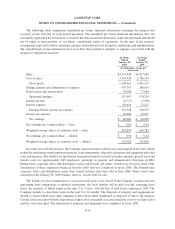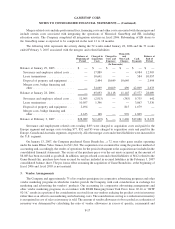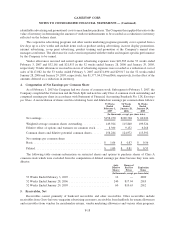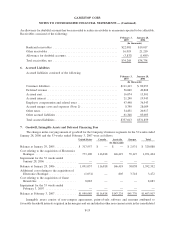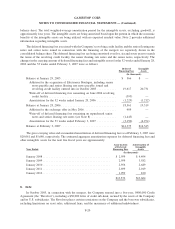GameStop 2006 Annual Report Download - page 79
Download and view the complete annual report
Please find page 79 of the 2006 GameStop annual report below. You can navigate through the pages in the report by either clicking on the pages listed below, or by using the keyword search tool below to find specific information within the annual report.generally did not enter into derivative instruments with respect to foreign currency risks, Electronics Boutique
routinely used forward exchange contracts and cross-currency swaps to manage currency risk and had a number of
open positions designated as hedge transactions as of the merger date. The Company discontinued hedge
accounting treatment for all derivative instruments acquired in connection with the mergers.
The Company follows the provisions of Statement of Financial Accounting Standards No. 133, Accounting for
Derivative Instruments and Hedging Activities (“SFAS 133”), as amended by Statement of Financial Accounting
Standards No. 138, Accounting for Certain Derivative Instruments and Certain Hedging Activities (“SFAS 138”).
SFAS 133 requires that all derivative instruments be recorded on the balance sheet at fair value. Changes in the fair
value of derivatives are recorded each period in current earnings or other comprehensive income, depending on
whether the derivative is designated as part of a hedge transaction, and if it is, depending on the type of hedge
transaction.
The Company uses forward exchange contracts, foreign currency options and cross-currency swaps, (together,
the “Foreign Currency Contracts”) to manage currency risk primarily related to intercompany loans denominated in
non-functional currencies and certain foreign currency assets and liabilities. These Foreign Currency Contracts are
not designated as hedges and, therefore, changes in the fair values of these derivatives are recognized in earnings,
thereby offsetting the current earnings effect of the re-measurement of related intercompany loans and foreign
currency assets and liabilities. The aggregate fair value of these Foreign Currency Contracts at February 3, 2007 was
a liability of $1,892, of which $2,540 is included in accrued liabilities, and $390 is included in other long-term
liabilities, with an offsetting amount of $1,038 included in other non-current assets in the accompanying
consolidated balance sheet. The aggregate fair value of these Foreign Currency Contracts at January 28, 2006
was a liability of $7,083, of which $6,513 is included in accrued liabilities and the remainder is included in other
long-term liabilities in the accompanying consolidated balance sheet. The Company had no forward exchange
contracts and currency swaps prior to October 8, 2005.
Net Earnings Per Common Share
Net earnings per common share is presented in accordance with Statement of Financial Accounting Standards
No. 128, Earnings Per Share (“SFAS 128”). Basic earnings per common share is computed by dividing the net
income available to common stockholders by the weighted average number of common shares outstanding during
the period. Diluted earnings per common share is computed by dividing the net income available to common
stockholders by the weighted average number of common shares outstanding and potentially dilutive securities
outstanding during the period. Potentially dilutive securities include stock options and unvested restricted stock
outstanding during the period, using the treasury stock method. Potentially dilutive securities are excluded from the
computations of diluted earnings per share if their effect would be antidilutive. Note 4 provides additional
information regarding net earnings per common share.
Stock Options
In December 2004, the Financial Accounting Standards Board (“FASB”) issued Statement of Financial
Accounting Standards No. 123 (Revised 2004), Share-Based Payment, (“SFAS 123(R)”). This Statement requires
companies to expense the estimated fair value of stock options and similar equity instruments issued to employees
in their financial statements. Previously, companies were required to calculate the estimated fair value of these
share-based payments and could elect to either include the estimated cost in earnings or disclose the pro forma effect
in the footnotes to their financial statements. We chose to disclose the pro forma effect for all periods through
January 28, 2006.
In March 2005, the SEC issued Staff Accounting Bulletin No. 107 (“SAB No. 107”) regarding the Staff’s
interpretation of SFAS 123(R). This interpretation provides the Staff’s views regarding interactions between
SFAS 123(R) and certain SEC rules and regulations and provides interpretations of the valuation of share-based
payments for public companies. Following the guidance prescribed in SAB No. 107, on January 29, 2006, the
F-11
GAMESTOP CORP.
NOTES TO CONSOLIDATED FINANCIAL STATEMENTS — (Continued)


